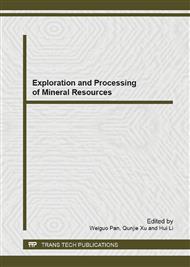p.403
p.408
p.412
p.417
p.423
p.429
p.433
p.437
p.442
Surface Modification Effects of Microorganism from Lignite on Fine Coal
Abstract:
One of the important directions of the research on coal washing is developing the non-toxic reagents with strong force and high selectivity. Compared with model strains, yeast designated Y21 as surface modifier for fine coal was isolated from lignite by traditional microorganism separation. Colony morphology, physiological and biochemical characteristics and some molecular sequence fragments show that the strain Y21 was Rhodotorula mucilaginosa. Through zeta-potential measurements and contact angle changes of coal samples caused by strain Y21, it was shown that strain Y21 can be selectively adhered onto the fine coal surface through the electrostatic interactions and the hydrophobic interactions. These observations lead to the conclusion that the adhesion of the yeast onto the coal surface could change zeta potential and the contact angle of coal particles. For both coal samples, the contact angle was sharply increased respectively in the pH range 3-4 and 2-4 as a result of Y21 strain adsorption. This indicates that as a result Y21 strain adsorption the coal surfaces have become more hydrophobic. These results indicated that the modified flotation and flocculation rate of fine coal particles were improved using the strain Y21 through changing the surface characteristics of coal.
Info:
Periodical:
Pages:
423-428
Citation:
Online since:
December 2013
Authors:
Keywords:
Price:
Сopyright:
© 2014 Trans Tech Publications Ltd. All Rights Reserved
Share:
Citation:


